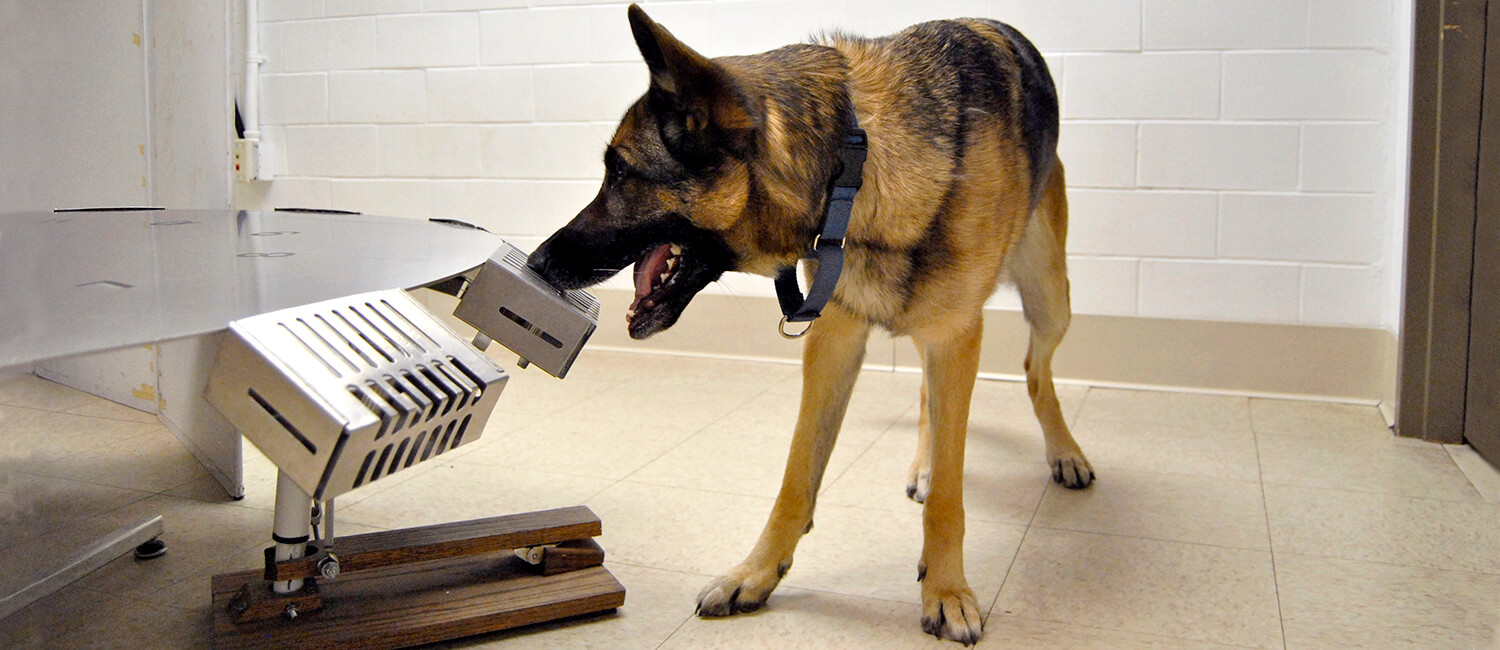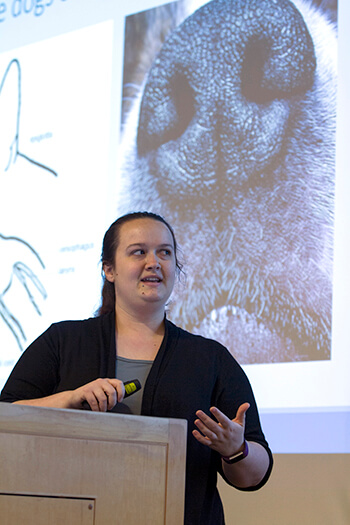 Osa, a 4-year-old German Shepherd, uses her incredible sense of smell to alert on malignant ovarian cancer at the
Osa, a 4-year-old German Shepherd, uses her incredible sense of smell to alert on malignant ovarian cancer at the
Penn Vet Working Dog Center.
At Penn, collaboration is as ingrained in the culture as innovation. And, it turns out, some teams end up having quite the crew. One specific group—working to detect early stage ovarian cancer—maintains experts spanning obstetrics and gynecology, chemistry, physics, and veterinary care. It also includes human’s best furry friends: dogs.
As part of the Center for Public Health Initiatives’ (CPHI) innovation-themed seminar series, this research—led by Janos Tanyi from Perelman School of Medicine’s Division of Gynecologic Oncology; A.T. Charlie Johnson, director of the Nano/Bio Interface Center; Cynthia Otto, director of the Penn Vet Working Dog Center; and George Preti, an organic chemist at the Monell Chemical Senses Center—was highlighted.
“What do you get when you pair animal behavior with odor?” asked Sara Solomon, CPHI’s deputy director, as she introduced the speakers. “Well, you get, apparently here, an early cancer detection system. I don’t know if it gets more innovative than that.”
 The “detection dog” talk, on Thursday, April 19, drew students, faculty, staff, and even community members from outside of Penn to Fagin Hall’s auditorium. Featured were Jennifer Essler, a postdoctoral fellow at the Working Dog Center who works closely with Otto, and Preti, from Monell, a nonprofit research center at 3500 Market St.
The “detection dog” talk, on Thursday, April 19, drew students, faculty, staff, and even community members from outside of Penn to Fagin Hall’s auditorium. Featured were Jennifer Essler, a postdoctoral fellow at the Working Dog Center who works closely with Otto, and Preti, from Monell, a nonprofit research center at 3500 Market St.
Essler showcased—with images and videos—how dogs at the Working Dog Center have been trained to use their incredible sense of smell to alert on malignant ovarian cancer, using plasma samples from patients that Tanyi is treating.
“Osa is currently the star,” said Essler, talking of the 4-year-old German Shepherd. Essler then showed a video of Osa meticulously sniffing a stainless-steel wheel, outfitted with ports containing a malignant sample, benign samples, and normal samples, as well as a mix of other “distractors.” Osa suddenly freezes and stares. She’s detected the cancer, and excitedly receives a toy for reward.
“They like getting it right,” Essler said. “It’s fun for them.”
Essler, who has a bachelor’s in psychology, a master’s in animal behavior, and a Ph.D. from the University of Veterinary Medicine in Vienna, Austria, explained how the Working Dog Center is seeing if it can, now, train dogs on cancer cell lines to alert on cancer plasma, which would reduce the need for increasing numbers of plasma samples.
Preti, an expert on the chemistry of human body odors, discussed his role in applying analytical techniques to identifying the volatile organic compounds (VOCs) in plasma, indicative of ovarian cancer. These VOCs, or odor producing chemicals, are now being presented to the working dogs.
“Body odor as a diagnostic function has a long history going back to Hippocrates,” said Preti, also an adjunct professor in Penn’s Department of Dermatology. “And if you think about it, going back a couple thousand years, physicians didn’t have much beyond their own senses to diagnose a disease with.”
Now, he continued, there are sophisticated instruments that can collect, separate, and identify odorants.
 “Consequently, the demonstration by the canines that ovarian cancer has an odor signature tells us that we can begin to isolate and identify this odor signature’s components,” he said. “Using the dogs as a sensitive bioassay, the odorants we collect/isolate can be presented to the dogs to see if the isolates’ ‘smell like ovarian cancer.’”
“Consequently, the demonstration by the canines that ovarian cancer has an odor signature tells us that we can begin to isolate and identify this odor signature’s components,” he said. “Using the dogs as a sensitive bioassay, the odorants we collect/isolate can be presented to the dogs to see if the isolates’ ‘smell like ovarian cancer.’”
The hope is that all this research will translate into a device that would be used at a clinic, said Preti. That’s where Johnson’s work comes in: The physicist is creating an electronic nose comprised of nanosensors that mimic the abilities of the dog’s nose. Essentially, the dogs are informing and refining what will be an electronic system.
The potential impact of a tool that can detect ovarian cancer early is massive, noted both Preti and Essler. Since there are rarely any early stage symptoms of ovarian cancer, it frequently goes undetected before it spreads. At a later stage, it becomes much more difficult to treat: The five-year survival rate of stage-IV ovarian cancer is only 17 percent.
However, if it’s detected in its earliest stages, it is especially treatable, with a five-year survival rate of over 90 percent.
Preti specifically mentioned the large role philanthropy has played in funding their “novel but rationale approach to a difficult problem.” Essler said: “Finding an early detection system for this cancer in particular could be really impactful and helpful for the community.”
The findings that the team has discovered throughout the past five years of collaborating together are nothing short of “remarkable,” Preti said. “They suggest that what we are proposing is not some far-out concept.”
And, better yet, there’s also the potential to use these findings, Preti added, “to help detect other types of cancer that are hidden, specifically pancreatic cancer, which has some genetic similarities to ovarian cancer.”
The entire, detailed CPHI seminar was recorded, and will soon be published on its website. Watch other talks from the innovation series here.
Photos courtesy of the Penn Vet Working Dog Center and Ben Pickup.